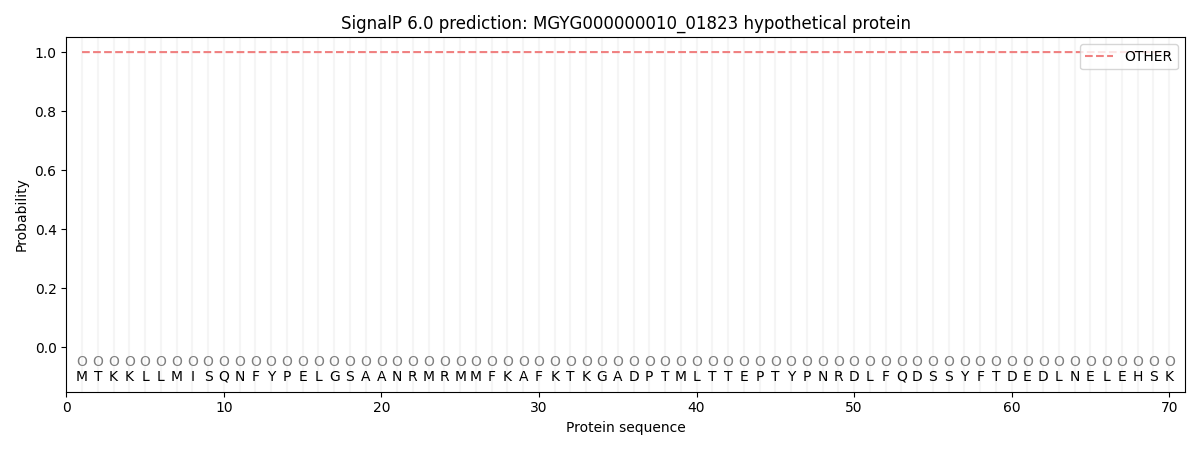You are browsing environment: HUMAN GUT
CAZyme Information: MGYG000000010_01823
You are here: Home > Sequence: MGYG000000010_01823
Basic Information |
Genomic context |
Full Sequence |
Enzyme annotations |
CAZy signature domains |
CDD domains |
CAZyme hits |
PDB hits |
Swiss-Prot hits |
SignalP and Lipop annotations |
TMHMM annotations
Basic Information help
| Species | Staphylococcus_A lentus | |||||||||||
|---|---|---|---|---|---|---|---|---|---|---|---|---|
| Lineage | Bacteria; Firmicutes; Bacilli; Staphylococcales; Staphylococcaceae; Staphylococcus_A; Staphylococcus_A lentus | |||||||||||
| CAZyme ID | MGYG000000010_01823 | |||||||||||
| CAZy Family | GT4 | |||||||||||
| CAZyme Description | hypothetical protein | |||||||||||
| CAZyme Property |
|
|||||||||||
| Genome Property |
|
|||||||||||
| Gene Location | Start: 38323; End: 39534 Strand: - | |||||||||||
CDD Domains download full data without filtering help
| Cdd ID | Domain | E-Value | qStart | qEnd | sStart | sEnd | Domain Description |
|---|---|---|---|---|---|---|---|
| cd03794 | GT4_WbuB-like | 1.40e-59 | 4 | 390 | 1 | 391 | Escherichia coli WbuB and similar proteins. This family is most closely related to the GT1 family of glycosyltransferases. WbuB in E. coli is involved in the biosynthesis of the O26 O-antigen. It has been proposed to function as an N-acetyl-L-fucosamine (L-FucNAc) transferase. |
| COG0438 | RfaB | 3.24e-15 | 82 | 395 | 56 | 376 | Glycosyltransferase involved in cell wall bisynthesis [Cell wall/membrane/envelope biogenesis]. |
| cd03820 | GT4_AmsD-like | 2.34e-05 | 88 | 384 | 68 | 351 | amylovoran biosynthesis glycosyltransferase AmsD and similar proteins. This family is most closely related to the GT4 family of glycosyltransferases. AmSD in Erwinia amylovora has been shown to be involved in the biosynthesis of amylovoran, the acidic exopolysaccharide acting as a virulence factor. This enzyme may be responsible for the formation of galactose alpha-1,6 linkages in amylovoran. |
| pfam13579 | Glyco_trans_4_4 | 3.55e-04 | 98 | 205 | 62 | 158 | Glycosyl transferase 4-like domain. |
| cd04949 | GT4_GtfA-like | 5.99e-04 | 66 | 381 | 15 | 325 | accessory Sec system glycosyltransferase GtfA and similar proteins. This family is most closely related to the GT4 family of glycosyltransferases and is named after gtfA in Streptococcus gordonii, where it plays a role in the O-linked glycosylation of GspB, a cell surface glycoprotein involved in platelet binding. In general glycosyltransferases catalyze the transfer of sugar moieties from activated donor molecules to specific acceptor molecules, forming glycosidic bonds. The acceptor molecule can be a lipid, a protein, a heterocyclic compound, or another carbohydrate residue. This group of glycosyltransferases is most closely related to the previously defined glycosyltransferase family 1 (GT1). The members of this family may transfer UDP, ADP, GDP, or CMP linked sugars. The diverse enzymatic activities among members of this family reflect a wide range of biological functions. The protein structure available for this family has the GTB topology, one of the two protein topologies observed for nucleotide-sugar-dependent glycosyltransferases. GTB proteins have distinct N- and C- terminal domains each containing a typical Rossmann fold. The two domains have high structural homology despite minimal sequence homology. The large cleft that separates the two domains includes the catalytic center and permits a high degree of flexibility. The members of this family are found in bacteria. |
CAZyme Hits help
| Hit ID | E-Value | Query Start | Query End | Hit Start | Hit End |
|---|---|---|---|---|---|
| QMU10593.1 | 5.85e-295 | 1 | 403 | 1 | 403 |
| QQT15812.1 | 2.84e-243 | 1 | 403 | 1 | 403 |
| QQY18891.1 | 2.84e-243 | 1 | 403 | 1 | 403 |
| QJF24716.1 | 5.73e-243 | 1 | 403 | 1 | 403 |
| QTN12456.1 | 8.14e-243 | 1 | 403 | 1 | 403 |
Swiss-Prot Hits help
SignalP and Lipop Annotations help
This protein is predicted as OTHER

| Other | SP_Sec_SPI | LIPO_Sec_SPII | TAT_Tat_SPI | TATLIP_Sec_SPII | PILIN_Sec_SPIII |
|---|---|---|---|---|---|
| 1.000045 | 0.000000 | 0.000000 | 0.000000 | 0.000000 | 0.000000 |
